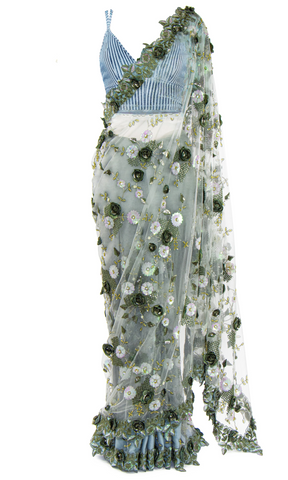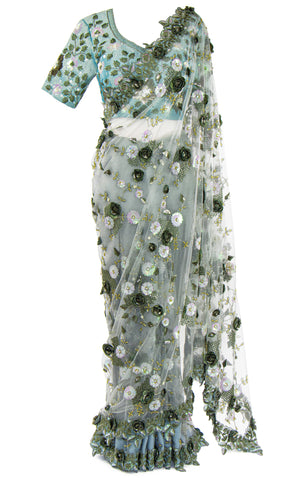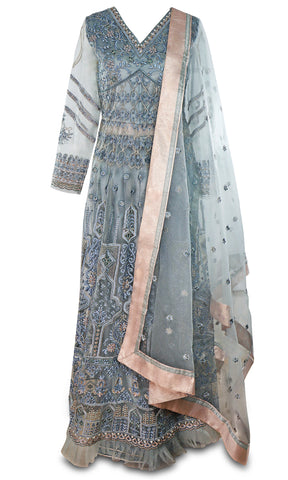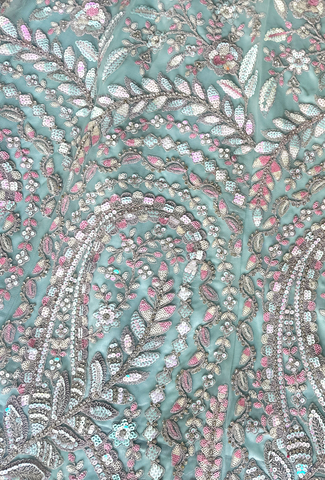Types of Indian Clothing
So, you have an Indian event to attend, but absolutely no idea what to wear... Sometimes even putting together a cute outfit for girls’ night is a struggle; so how are you expected to navigate the world of Indian clothing? At first glance, Indian clothing might seem daunting, scary, and overly complicated. You might only be familiar with the iconic Saree, but there are so many other outfits and dress types to choose from that are both glamorous and gorgeous!
We want to make it easy for you to know the differences so you can pick the style that compliments you best. Let’s break down the different Indian dress types and which events they can be worn at.
Women’s Wear
Saree/Sari
The Saree/Sari is the most traditional Indian dress and is thought to have originated as early as 2800 BC in the Indus Valley. In Sanskrit, it translates to “strip of fabric” which makes sense when you consider that most Saree's are between 6-8 yard of fabric! The Saree is a timeless outfit that never goes out of style. It is wrapped, pleated, and draped across the shoulder with excess fabric hanging behind. Depending on how it is styled, a Saree can be draped to cover the entire body or to show more skin. The timeless elegance of the Saree makes it perfect for any event. The Saree consists of 3 parts:
- A petticoat worn underneath (which we provide!)
- A cropped blouse
- 6-8 yards of fabric wrapped around the petticoat to form a skirt (we send yours pre-pleated! Trust me, even watching a few YouTube videos of “how to pre-pleat a saree” will make you appreciate a pre-pleated one!)
Lehenga/Lengha
The lehenga/Lengha is the original crop top and skirt set. It is also made up of 3 parts:
- A cropped top known as a Choli (Are tops are all adjustable!)
- A skirt known as the Lehenga (again, very adjustable!)
- A long scarf known as the Dupatta
The lehenga is one of the easiest outfits to dance in and acceptable at almost all types of events. It is also one of the most versatile outfit types as the Lehenga bottom can be paired with a cape style top, long jacket style top, and various other styles. Some modern styles even include a side-slit in the Lehenga skirt. Whether you choose to wear your Lehenga at an engagement, sangeet, or reception, the elegant draping and stunning embroidery are sure to turn heads!
Anarkali
Legend has it that the Anarkali was named after a courtesan of Great Emperor Akbar’s court from the Mughal Era. Think of the type of flowy midi dresses you wear in the summer when thinking of an Anarkali. An Anarkali consists of 3 parts:
- A long flowing top known as the Kurta
- Leggings or pants known as the Churidaar
- A long scarf known as the Dupatta
The Anarkali is a versatile outfit that can be worn to any event. It is the perfect choice if you are unsure of what to wear. And because the Kurta top is often cut in an A-line shape, the Anarkali is one of the most flattering dress types.
Sharara Suit
Think 70s disco pants when thinking of a Sharara. It is a 3-piece outfit that can be identified by its unique wide leg flowy pants. Some styles of sharara are looser while others are tighter at the thighs and flare out starting above the kneecap. The Sharara Suit is fun and playful and the perfect outfit for a mehndi or sangeet. It can also be worn for the wedding ceremony. The Sharara Suit consists of the following:
- Wide leg pants
- A blouse that can vary in length
- A long scarf known as a Dupatta or a longline vest
Salwar Kameez
The Salwar Kameez is commonly known as a Punjabi suit. It has more simple lines than the previously mentioned outfit types but can be just as elaborate depending on the type of fabric used and the detail of the embroidery. The Salwar Kameez is typically two pieces, but it usually worn with a Dupatta making it a 3-piece fit as well
- Pleated pants fitted at the ankles and wide at the thighs known as the Salwar
- A tunic type top varying in length known as the Kameez
- A long scarf known as the Dupatta
The simple elegance of the Salwar Kameez makes it an easy to wear outfit perfect for a sangeet, mehndi, or wedding ceremony. While it can be worn to a reception if the embroidery is very heavy, other dress types are typically favored.
Most Indian women today pick their outfits based on a personal preference of what makes them feel beautiful rather than adhering to traditional guidance on what dress styles are better suited for what wedding event. As long as you are adhering to and respectful of religious customs as a guest, you are free to wear whatever type of dress you want!
Men’s Wear
Kurtas
A Kurta is a collarless shirt made of rectangular pieces that are stitched together with seams along the side of the shirt. The side-seams are left open at the bottom up to varying lengths to allow for easier movement. A Kurta is effortless yet sophisticated, making it perfect for all occasions. Keep in mind that you should not choose the color black for your Kurta if you plan to wear it for the wedding ceremony. Black at all other occasions looks polished and is highly recommended. Since it is less formal than a Sherwani, a Kurta is our go-to option for menswear.
Sherwani
The Sherwani was originally associated with Mughal royalty and gained mainstream popularity for its well-fitted silhouette and refined look. A Sherwani looks very similar to a Kurta but is distinguished by its much thicker fabric and regal look. A Sherwani often has vertically placed buttons along the chest which elongate the eye and create an illusion of height. You can think of a Sherwani as a formal coat and the Kurta as more of a dress shirt that is worn underneath. For this reason, a Sherwani is best for the wedding ceremony.
Want to learn why renting Indian clothing is a better option than buying? Then read here!
Want to learn what is an acceptable attire for different types of Indian weddings? Then read here!
Want to learn more about all the different Indian wedding ceremonies? Learn here!









































































